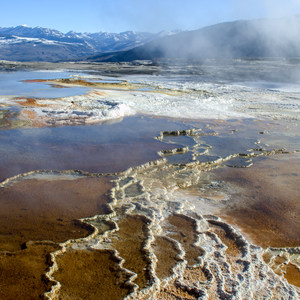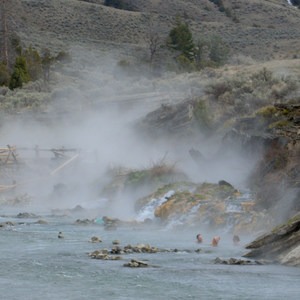Yellowstone National Park is a geologic wonderland. This alpine environment rimmed by high peaks and teeming with wildlife overlays a giant hotspot in the Earth's crust known as a supervolcano--where magma seethes especially close to the surface. Scientists see no imminent danger of an eruption; rather, we get to enjoy the consistent and gradual release of subterranean heat in the form of thousands of hydrothermal features in Yellowstone.
The word hydrothermal describes the interaction of heat and water. Energy from volcanic activity super-heats groundwater, meaning it is taken far past the boiling point but kept from boiling due to immense pressure underground. This pressure drives it to the surface, where it releases in any number of phenomenal ways. The most spectacular of these is geysers, but the release includes a variety of other forms like hot springs, mudpots, and fumaroles. Yellowstone National Park contains more than 10,000 hydrothermal features, including more than half of the geysers known on Earth.
Geysers
Geysers are a venting of hot groundwater that have one or more constrictions somewhere along the water's path to the surface. These pinch points cause super-heated water to build up as it rises from deeper underground, until the pressure is no longer containable and it rockets through the constriction with so much force that it shoots water and steam high into the sky. Geysers are generally quite rare on our planet, but they usually occur in clusters where geologic conditions are just right. Yellowstone is the best place of all, with more than 500 geysers identified.
The great majority of them are unpredictable as to when they erupt, meaning they go off rarely, and catching an event is sheer luck. A handful are predictable, though, meaning that they usually erupt within a reasonable range of a certain interval. The schedule is different for each geyser, so check with the park service to find out when a particular geyser's next eruption might be. You can also use the GeyserTimes mobile app for real-time updates.
Most Predictable
The aptly named Old Faithful is the world's most famous geyser because of its highly regular intervals. It erupts every 90 minutes on average, shooting water more than 100 feet high. Daisy, which is also in Upper Geyser Basin, comes a close second, erupting at approximately 2.75-hour intervals in a 75-foot column.
Tallest
Steamboat, in Norris Geyser Basin, is the world's tallest active geyser, though its eruptions are completely unpredictable and rare. When it does go off in a major event, it exceeds 300 feet and can last more than half an hour. For your best chance at seeing a geyser taller than Old Faithful, visit Grand or Beehive, both in Upper Geyser Basin. Both are fairly predictable, but it is still not easy to catch a major eruption.
Most Active
This is a tough one to measure, because the activity of many geysers changes through the years. There are also small geysers in Yellowstone that erupt nearly continually. For your best chance of seeing an impressive geyser, go to Anemone in Upper Geyser Basin. It erupts every 10 minutes or less in a 6-foot-high spurt of water. Jewel Geyser in Biscuit Basin is another good bet, which erupts fairly often in a 10-30-foot column. Cliff Geyser in Black Sand Basin sputters nearly continuously, but it can occasionally reach heights of 40 feet.
Others
Among the active geysers in Yellowstone, a few others are fairly predictable. Riverside, in Upper Geyser Basin, erupts from a picturesque pool along the Firehole River. Great Fountain is Lower Geyser Basin's only predictable geyser, and it produces one of Yellowstone's longest eruptions when it does go off. A 75-foot-high or taller fountain of water erupts for between one and two hours at a time.
Hot Springs
Hot Springs originate from the same geothermally heated water as geysers, but in this case they do not have a constriction that builds up pressure, so they bubble or flow continuously rather than erupt. Hot springs are the most common type of hydorthermal feature in the park, and they can be found throughout the geyser basins and elsewhere. What makes Yellowstone's hot springs stand out are the colors that occur in some of them. These colors are caused by microscopic organisms called thermophiles that thrive in the extremes of hot, mineral-rich water. Because many of Yellowtone's hot springs are dangerously hot, acidic, or otherwise dangerous, soaking is not allowed in most of the park. Here are some of the most spectacular springs as well as the two you can take a dip in.
Viewing
- Grand Prismatic Spring and others in Midway Geyser Basin
- Mammoth Hot Springs
- Morning Glory, Heart, Chromatic, Beauty, Crested, and other pools in Upper Geyser Basin
- Emerald Pool and Rainbow Pools in Black Sand Basin
- Sapphire Pool in Biscuit Basin
- Celestine Pool in Lower Geyser Basin
Soaking
- Boiling River: Near the park's north entrance in Montana, where a hot river meets a cold one, is the perfect mix of temperatures for soaking year round.
- Firehole River: The swimming area on the Firehole is not actually at a hot spring, but the river's water is warmed (somewhat) by the hot springs and geysers that feed it upstream
Mudpots
Bubbling cauldrons of soupy mud, like something from a creature feature, are actually natural and fairly common in Yellowstone. They occur when surface water collects in pools and is mostly cut off from ground water by a lining of clay, but it is heated by steam rising up between the rocks below. When this steam includes sulfur gas from volcanic activity, the water becomes acidic and partially dissolves surrounding rock into clay, which turns the pools to mud. Pressure from rising steam is trapped by the viscosity until it releases as bubbles or even small geyser-like eruptions. Mudpots are some of the most bizarre of Yellowstone's thermal features.
- Mud Volcano and Sulphur Cauldron: an area of many active mudpots and steam vents, some of which have only emerged in recent decades.
- Artist Paint Pots: colored by a variety of dissolved minerals, and set against an inspiring alpine backdrop.
- Fountain Paint Pots: Gurgling pot amid an area of very active geysers.
Other Features
Fumaroles
These are vents that spout steam from the ground, but more continuously and in lower volume than geysers. They can be found throughout most of Yellowstone's thermal areas.
Travertine Terraces
When mineral-rich water spills out onto the surface and evaporates, dissolved solids are left behind. When much of this is calcium carbonate, the major component of limestone, the particles join together to create a rock-like substance called travertine. Constantly flowing water leaves travertine residue behind in structures resembling a giant, frozen fondue pot. Accented by streaks of color from thermophiles living on their surface, travertine terraces are a particularly aesthetic creation of Yellowstone's hydrothermal activity. The best place to see them is at Mammoth Hot Springs.







Comments
Sign In and share them.